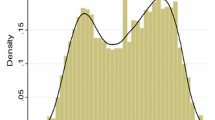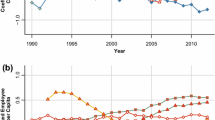Abstract
Myrskylä et al. (2009) found that the relationship between the human development index (HDI) and the total fertility rate (TFR) reverses from negative (i.e., increases in HDI are associated with decreases in TFR) to positive (i.e., increases in HDI are associated with increases in TFR) at an HDI level of 0.86. In this article, we show that the reversal in the HDI-TFR relationship is robust to neither the UNDP’s recent revision in the HDI calculation method nor thedecomposition of the HDI into its education, standard-of-living, and health subindices.


Similar content being viewed by others
Notes
The revision of the HDI mostly had a level effect. Changes in the country rankings were moderate. In the MKB sample, the average absolute change was three positions in 2005.
The use of the period TFR is subject to an ongoing debate among demographers. The TFR is a rather volatile and possibly misleading indicator because of tempo effects. Although we agree that tempo effects are important, they are not the focus of this note. We study the robustness of MKB’s main result and thus use the same indicator as MKB.
We exclude Hong Kong, Macao, Monaco, and Singapore from the analysis.
Data for 1980 can be found in Table S1 of Online Resource 1.
The original MKB sample is presented in Table S2 in Online Resource 1.
The unbalanced sample consists of 157 countries, which are listed in the footnote of Table S1. The unbalanced sample of countries includes countries for which some data points are missing but that are nevertheless important for the analysis—for example, Germany and many low-fertility countries from Eastern and Central Europe.
MKB rescaled HDI and TFR as follows: HDI rescaled = −log(1−HDI) and TFR rescaled = log(0.4886 · TFR/31.
See the online supplement for Myrskylä et al. (2009) for a more detailed description.
We use all values between 0.01 and 0.99, with a step size of 0.01, as potential thresholds.
The estimation of the threshold value depends on the underlying sample of countries. MKB excluded countries that had not reached an HDI of 0.85 in 2005. Because we use different samples of countries, we provide a robustness check on this selection criterion when estimating the threshold value.
For the old HDI, we use the data MKB used.
The log-likelihood for various threshold values is shown in Fig. S2 in Online Resource 1.
The results are not driven by outliers. MKB identified Estonia, Kuwait, South Korea, and Malta as outliers. In a robustness check, we omitted these countries from the sample and obtained essentially the same results.
The log-likelihood of the various threshold values of the piecewise linear regressions for the HDI subindices is shown in Figs. S3–S5 in Online Resource 1.
References
Myrskylä, M., Kohler, H.-P., Billari, F. C. (2009). Advances in development reverse fertility declines. Nature, 460, 741–743.
UNDP. (2010). Human development report 2010. The real wealth of nations. Pathways to human development. New York: UNDP.
UNDP. (2011). International human development indicators. New York: UNDP.
World Bank. (2011). World development indicators [CD-ROM]. Washington, DC: World Bank.
Acknowledgments
For their valuable comments and suggestions, we thank Stephan Klasen, Klaus Prettner, and Holger Strulik; three anonymous referees; the Editor, Stewart E. Tolnay; and participants of the 2013 Alp-Pop Conference.
Author information
Authors and Affiliations
Corresponding author
Electronic supplementary material
Below is the link to the electronic supplementary material.
Rights and permissions
About this article
Cite this article
Harttgen, K., Vollmer, S. A Reversal in the Relationship of Human Development With Fertility?. Demography 51, 173–184 (2014). https://doi.org/10.1007/s13524-013-0252-y
Published:
Issue Date:
DOI: https://doi.org/10.1007/s13524-013-0252-y




